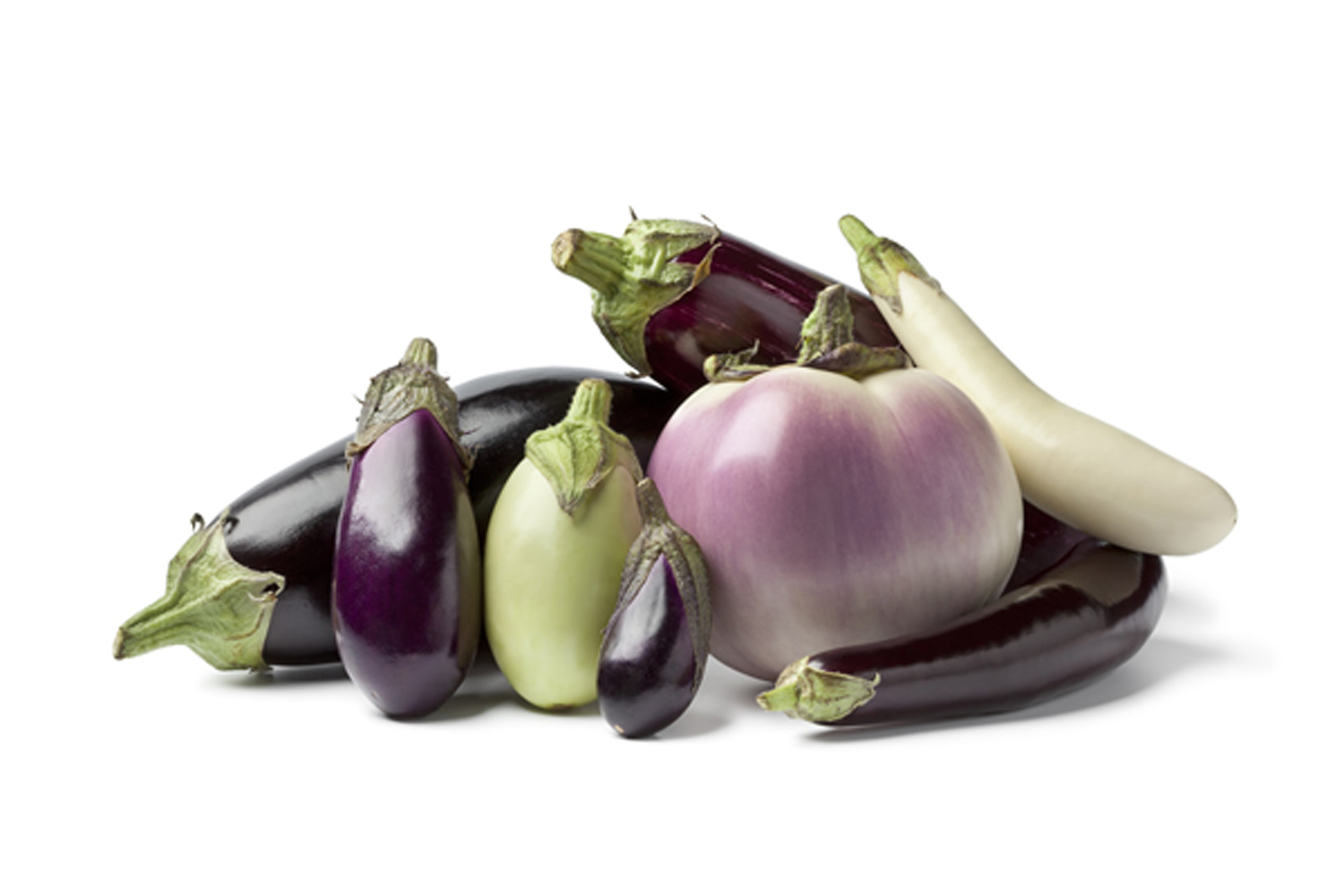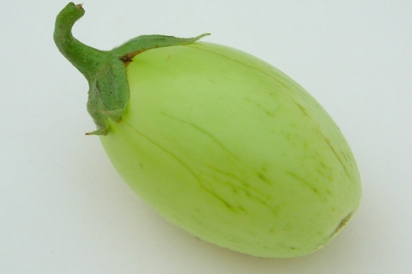All About Eggplant
North Americans’ love affair with the world of tomatoes began about 150 years ago. Our passion for peppers began about fifteen years ago. However, our curiosity about eggplants (the close cousin of both tomatoes and peppers) is barely beginning.
The eggplant has been devotedly used in India for over 3,500 years and the Chinese have been cultivating them for over 2,500 years, but the Greeks and Romans inexplicably did not know of them. Use in Europe is not recorded until just over 500 years ago—and then, only as a peculiar ornamental. It had small white fruits about the size of hen eggs. And so the English christened it “eggplant.”
Some Europeans eventually started to eat them, but it was commonly believed that eggplants made people insane. The Italians continue to call the fruit melanzana (insane apple), and the English still understand that a “mad apple” is an eggplant. These days only Canadians, Americans, and Australians continue to use the eggplant moniker. The English (and the French, of course) call them aubergines, after the Catalan alberginia, derived from the Arabic al-badinjan, which itself comes from the Persian bâdengân. All of these names likely evolved from the original name for eggplant—bhaṇṭākī or vatin-ganah (depending on the source) in Sanskrit—as did brinjal, the current-day Indian name.
Nutrition
The eggplant is low in fat, carbohydrates, protein, vitamins, and minerals. It is, however, a good source of important antioxidants and phytonutrients. Since its spongy texture readily absorbs whatever it is cooked with, you can take advantage of the appealing meaty texture and add nutrients from other sources.
Purchasing Eggplants
Most eggplants seen in stores are purple-skinned in varying shapes and sizes, some being thin and pendulous and others, round or oval. Some are all white and others have gorgeous purple and white stripes. At farmers’ markets you may encounter Louisiana Long Green eggplants, my favourite green-skinned variety. For dicing and mashing, larger eggplants are more convenient; where the purple skin will be attractive, as in stir-fries or ratatouille, the pendulous form with more skin is preferred.
Though seemingly sturdy, eggplants do not remain at their peak much longer than do tomatoes. First check to see that the green calyx (the husk crowning the stem end) is a bright green and there are no sunken brown spots. Then the most reliable way to confirm freshness is to press the skin with your thumb. If you can’t make an indentation, the fruit was picked unripe and will never improve. If you can make an indentation that promptly springs back, this is one to take home. If the indentation fails to spring back, it is overripe or spoiling. Of course, this manipulation is not considerate to the produce manager; but on the other hand, a considerate produce manager should have already done this for you (and discarded any rejects). Hefting the fruits is more difficult to describe, but easy to do; heavy (for its size) is under-ripe, while lightweight (for its size) is over-mature. Both tend to be too bitter.
Store your eggplant unwrapped in a cool location. (Oh how I wish refrigerators came with a 10º C compartment for tomatoes, peaches, melons, basil, and eggplant.)
Quality Growing
Eggplants require plenty of heat and light to produce healthy bedding plants. Then very few plants are needed to supply a family (or even a community) through the summer, so it makes sense to purchase bedding plants from a nursery. There are two problems with this strategy, however: the plants are typically ready long before they should be transplanted outside; and you might have few choices of variety.
Purchasing your plants the third week of May can rectify the first problem. Then mix two-thirds transplant mix with one-third of your garden’s topsoil. Transplant your plants into 4-inch pots with this blend. (Getting them acclimated to your soil’s biology speeds acclimation after planting them outside.) Keep the plants in a protected sunny location on warm days. Bring them inside when temperatures are projected to fall below 10º C.
Starting your own seeds solves the second problem. I frankly do not find much difference in flavour between various varieties. So select them for size, shape, and colour. Heirlooms that have stood the test of time include:
- Black Beauty, the first (1902) medium-sized purple variety;
- Rosa Blanca, a pretty round purple/white choice;
- Louisiana Long Green, an exceptionally fine-tasting choice;
- Little Finger, a slender Asian variety meant to be harvested when 5 inches long.
The modern hybrids have an advantage in that they have earlier harvests because they can set their first fruits. Gentle finger-flicking of the early flowers around 11:00 on sunny June mornings can alleviate this delay. Note that white-skinned varieties have tough skin that generally needs to be peeled off.
Seeds should be started indoors the last week of March to be transplanted outside the second week of June. Germination should be at 25º C. Then grow them at 20º C in a south-facing window or with added artificial light.
When moving bedding plants into the garden, the soil should be about 15º C with little chance that overnight temperatures will fall into the single digits. Provide your plants with adequate room by giving them at least 24 inches in each direction. Eggplants are a favourite target of flea beetles and potato bugs. If these are problems in your area, completely cover small plants with row cover to exclude these pests. Larger plants are more tolerant.
Eggplants love heat, so if the summer is a cool one, leaving a row cover over them keeps them happier. In windy locations, tie plants to stakes before the fruits start swelling. When the fruits have reached full size, check for maturity, then cut off the woody stems with pruning shears. Leaving mature fruits unharvested will reduce later harvests.
Uses for Eggplant
There are a myriad of uses for eggplant in South- and East-Asian curries and stir fries. Classic European eggplant preparations include French ratatouille, Italian eggplant parmigiana, Greek moussaka, Turkish imam bayildi, and Lebanese baba ghanoush.
Eggplant must be cooked. Taste a sliver of the raw eggplant to determine if it has too much bitterness for your palate. Reduce this by sprinkling a couple of tablespoons of salt on your sliced or cut eggplant and let it sit for an hour or two. Then rinse off the salt and pat dry. This step also reduces the amount of oil the eggplant will absorb during cooking.
Eggplant Caviar
Makes 2 cups
Charred eggplant skin adds a marvellous smoky aroma to eggplant’s delicate flavour.
- 2 medium purple (Black Beauty) eggplants with fresh green calyxes (the husk crowning the stem end) attached
- 3 tbsp extra virgin olive oil
- 1 small onion, diced
- 1 medium sweet red pepper, diced
- 1/2 jalapeño pepper, seeded and minced
- 2 medium tomatoes, peeled, seeded, and diced
- 2 tbsp chopped fresh parsley
- 1 tbsp freshly squeezed lemon juice, plus more if needed
- 1/2 tsp sea salt, plus more if needed
Preheat the grill on high (or the oven to 500º F). Using a paring knife, poke two holes into each eggplant to release steam and prevent a messy explosion. Grill the eggplants (or place them on a parchment-lined baking sheet and roast them) until well charred, about 25 minutes. Remove the eggplants from the grill (or oven) and let cool completely. Cut the eggplants open and scrape out the flesh. Coarsely chop the flesh; transfer to a colander to drain.
In a large sauté pan or skillet, heat the oil over medium-high heat. Add the onion, red pepper, and jalapeño pepper and sauté, stirring occasionally until the onion is lightly browned, about 5 minutes. Stir in the tomatoes, parsley, lemon juice, and salt. Stir in the drained eggplant. Taste and adjust the seasonings, as needed.
Remove the eggplant from the heat and serve it warm as a condiment or a spread on hearty bread or crackers. Or transfer it to a covered container and refrigerate for up to two weeks. When serving the eggplant cold, taste and adjust the seasonings, as needed. (Refrigeration tends to mute the intensity of seasonings.)






